Laurence Hartnett: Difference between revisions
RjwilmsiBot (talk | contribs) m →External links: Adding Persondata using AWB (7393) |
Lloyd-Hartnett link |
||
| Line 27: | Line 27: | ||
Hartnett continued to make important contributions to Australian motoring after he left GMH. He instigated an ambitious venture to build a uniquely Australian car, the Hartnett, based on a design by Frenchman, [[Jean-Albert Grégoire|Jean Gregoire]].<ref name=Davis>'Aussie Cars' by Pedr Davis, 1987</ref> The Hartnett was a front wheel drive design, with an air cooled, 600cc, horizontally opposed two sylinder engine.<ref name=Davis/> The venture failed, after problems with the supplier of the aluminium body panels. Approximately 120 cars were produced between 1949 and 1955<ref name=Davis/>, and few of these survive today. |
Hartnett continued to make important contributions to Australian motoring after he left GMH. He instigated an ambitious venture to build a uniquely Australian car, the Hartnett, based on a design by Frenchman, [[Jean-Albert Grégoire|Jean Gregoire]].<ref name=Davis>'Aussie Cars' by Pedr Davis, 1987</ref> The Hartnett was a front wheel drive design, with an air cooled, 600cc, horizontally opposed two sylinder engine.<ref name=Davis/> The venture failed, after problems with the supplier of the aluminium body panels. Approximately 120 cars were produced between 1949 and 1955<ref name=Davis/>, and few of these survive today. |
||
Then, in 1957, he was involved in production of the Lloyd-Hartnett car, based on a German design. This venture also experienced misfortune, as Borgward, the German supplier of parts for the car suffered financial problems. |
Then, in 1957, he was involved in production of the [[Lloyd-Hartnett]] car, based on a German design. This venture also experienced misfortune, as Borgward, the German supplier of parts for the car suffered financial problems. |
||
{{-}} |
{{-}} |
||
==Promotion of Nissan== |
==Promotion of Nissan== |
||
Revision as of 23:04, 20 November 2010
Sir Laurence John Hartnett CBE (26 May 1898 – 4 April 1986) was an engineer who made several important contributions to the Australian automotive industry.
Appointment as Managing Director of General Motors- Holden
Born in the United Kingdom, he was brought to Australia in 1934 by General Motors to head up its Australian subsidiary General Motors Holden (GMH), which it had acquired in 1931. At the time of his appointment as Managing Director, GMH was performing poorly, and Hartnett's brief was to either turn around the floundering business or close it down.
Hartnett successfully turned around the fortunes of the local subsidiary, which operated as a bodybuilder for imported car chassis, to the extent that in 1935, the company increased production to over 23,000 bodies, and declared a profit of 650,000 pounds.
In 1936, Hartnett instigated plans for production of an Australian car- these plans finally came to fruition in 1948, with the introduction of the Holden.
Commonwealth Aircraft Corporation
Hartnett was instrumental in GMH becoming a founding shareholder of the Commonwealth Aircraft Corporation (CAC) in 1936, together with several other major Australian companies.
Contribution to Australia's War Effort
During World War II, Hartnett was appointed as Director of Ordnance Production by the Australian Government, and he made an important contribution to Australia's War effort.
Also, CAC made significant contributions, including design and production of the CAC Boomerang- the only fighter plane designed in Australia.
Father of the Holden
After the War, Hartnett returned to GMH and continued to pursue the goal of producing an Australian car. This involved compromise with General Motors in Detroit, as Hartnett favoured development of a local design, while Detroit preferred to see a US design as the basis for "Australia's Own Car". Ultimately, shortly before the launch of the Holden in 1948, Hartnett resigned from his position as Managing Director of GMH.
Life after GMH

Hartnett continued to make important contributions to Australian motoring after he left GMH. He instigated an ambitious venture to build a uniquely Australian car, the Hartnett, based on a design by Frenchman, Jean Gregoire.[1] The Hartnett was a front wheel drive design, with an air cooled, 600cc, horizontally opposed two sylinder engine.[1] The venture failed, after problems with the supplier of the aluminium body panels. Approximately 120 cars were produced between 1949 and 1955[1], and few of these survive today.
Then, in 1957, he was involved in production of the Lloyd-Hartnett car, based on a German design. This venture also experienced misfortune, as Borgward, the German supplier of parts for the car suffered financial problems.
Promotion of Nissan
Hartnett's luck changed in 1960, when he saw a new Japanese car - the Datsun Bluebird - on display at the Melbourne Motor Show. Hartnett commenced importing the Datsun to Australia, hence pioneering the importation of Japanese cars to Australia. This became a successful venture, and Hartnett was responsible for popularising the Nissan/ Datsun brand in Australia.
In 1966, Hartnett sought to establish local production of Nissan cars, but this was not successful. Nissan went on to assemble cars from CKD kits at the Pressed Metal Corporation plant in Sydney, followed in 1976 by assembly at the Melbourne factory where Volkswagen cars were once produced. Ultimately, Nissan commenced full production of cars in Australia.This arrangement continued until 1992,when the Melbourne plant was closed in favour of importing cars direct from Japan.
Hartnett's legacy
Hence, Hartnett has left a legacy of playing a crucial role in the introduction of two of Australia's best selling brands of cars - Holden and Nissan.
Hartnett Award
In honour of Sir Laurence Hartnett, in 1965, the Society of Automotive Engineers Australasia established the Hartnett Award as an annual award for an outstanding original contribution to automotive or aeronautical engineering knowledge or practice.
See also
References
Autobiography: Big Wheels and Little Wheels.Lansdowne Melbourne. 1964
